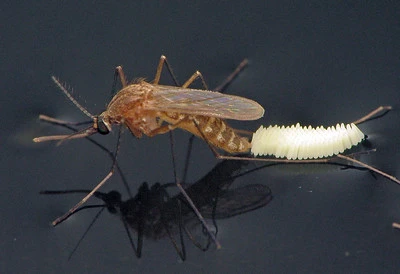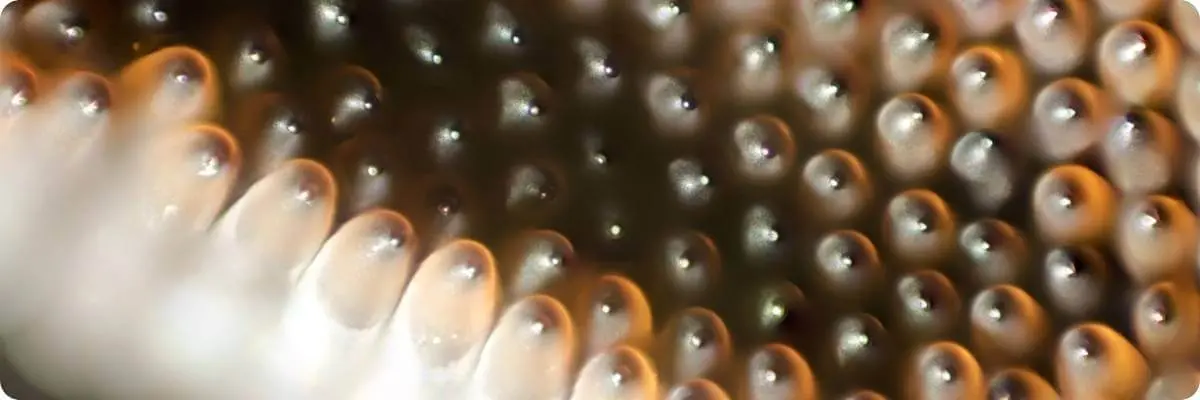It’s hard to imagine that a tiny little speck of an egg could damage our health, but a mosquito egg certainly can.
Mosquito eggs represent the first stage of a mosquito’s life cycle and are where all the magic starts in terms of that insect transforming into a full-blown blood-sucking machine. Mosquito eggs are unique little things in their own right, and whether you’re battling mosquitoes outside or inside, understanding more about them is an essential step toward winning the war.
Table of Contents
What Do Mosquito Eggs Look Like?
Mosquito eggs can be divided into 3 groups:
- those that are stuck together to form a raft and float on the water
- eggs that are laid singly on the water surface
- mosquito eggs that are laid singly out of the water

Whatever the group, mosquito eggs can be almost impossible to see with the naked eye as they are tiny. If the eggs are in a raft, as in the photo, they will be slightly easier to see.
In the photo, the size of the Culex mosquito is magnified several times, and even if these eggs are in a raft on the water surface, you will need to be very attentive to see them.
The eggs are white when first laid, but they darken quite quickly.
The size of an egg raft may only be 1/4 inch long by 1/8 inch wide.
Other mosquitoes lay their eggs singly in water. The eggs of the Anopheles mosquitoes, which are laid on the water’s surface, have a float on each side of the egg.
You may be able to see the floats on the eggs in the magnified photo; they have a lighter color.
When first deposited, the eggs are white, darkening in 12 to 24 hours.
Then some mosquitoes lay their eggs on a surface that will be covered with water when it rains or on soil, waiting for the rain to cause floods that will submerge the eggs. The eggs are white when first laid, and they darken to brown or black as the surface hardens to protect the egg.
These single mosquito eggs are very hard to see; they look like dirt. You will probably need a magnifying glass to ensure it is a mosquito egg. An individual egg can be 1/50 – 1/32 inch (0.5 – 1mm) long.
In the video below, you can see an Aedes aegypti mosquito laying her eggs, how they look when first laid and later when they become darker.
Where Do Mosquitoes Lay Their Eggs?
Mosquitoes lay their eggs either:
- directly in water
- above the waterline on a damp surface, such as the inside of a manmade or natural container that holds water
- at the edges of pools of water that rise and fall with rainfall and drought
- on damp soil where they will hatch after rainfall or flooding
Some of the places you may find mosquito eggs are in manmade containers (flower pots, tin cans, buckets, birdbaths, tires…), water barrels, paddling pools, untreated swimming pools, animal drinking troughs, ponds, ditches, marshy or waterlogged areas, blocked gutters or on plastic sheets where water can gather. Even a tiny amount of water is enough to attract a female mosquito.
Different species have distinct egg-laying behaviors, and understanding these oviposition behaviors can help with the development of mosquito surveillance or control methods.
For example, the Aedes aegypti and the Aedes albopictus, which are vectors for several diseases, prefer to lay their eggs in artificial and natural containers. This has led to the development of ovitraps for this mosquito species.
When Do Mosquitoes Lay Their Eggs?
In general, mosquitoes lay eggs throughout the summer and into autumn, although they may lay eggs all year round in milder climates. The female mosquito must first have a blood meal to produce her eggs.
Some species that die in cold weather lay their eggs in the autumn, and the eggs survive the winter to hatch when the spring rains and milder weather arrive.
Can Mosquitoes Lay Eggs Without Water?
Although mosquito eggs require some water to hatch, not all mosquitoes lay their eggs directly in water. While some species (Culex, Culiseta) lay their eggs in rafts on the water’s surface, others (Anopheles) lay their eggs singly in the water. In contrast, floodwater mosquitoes, such as the Aedes genus, lay their eggs on damp soil, in tree holes, or in containers just above the waterline.
The Aedes eggs will be covered with water when the rain comes, and the larvae will hatch. These eggs are resistant to drying out, can survive dry conditions for about 8 months, and can even successfully pass the winter in certain conditions.
Can Mosquitoes Lay Eggs in Your House?
If there are damp areas or small pools of standing water in your house, you may find mosquito eggs. So, yes, mosquitoes can lay eggs in your home.
Some common sites indoors where you may find mosquito eggs or larvae are:
- decorative plant pots or saucers
- flower vases
- the drip pans under refrigerators, dehumidifiers, or A/C units
- blocked or unused drains
- shower evacuations that are rarely used
- an uncleaned pet drinking bowl
If you often have mosquitoes in your home and have any of these water collection sites in your house, clean them out and change the water regularly, ideally at least once a week. Keeping the skeeters out of your home by using window/door screens and eliminating breeding sites outside may help you avoid these chores.
How Many Eggs Can a Mosquito Lay?
Depending on species and conditions, a mosquito can lay from 50 to 300 eggs.
Can Mosquitoes Lay Eggs Without Blood?
Blood provides the proteins needed for a female to produce her egg. Male mosquitoes don’t bite as they don’t need the extra protein to produce eggs; they feed on nectar and plant juices.
While most mosquitoes require a blood meal before they can produce eggs, some mosquitoes, such as the Toxorhynchites, also known as the elephant mosquito, rely on a sugary diet of nectar, fruit, and sap from damaged plants to produce their eggs.
Of the mosquitoes that need blood to produce their eggs, not all bite humans. Many prefer other mammals, reptiles, birds, or amphibians. Biting a human may be because they can’t find another suitable host.
A surprising fact
As mentioned above, mosquitoes do normally require blood to develop a batch of eggs. However, some individuals from certain species can produce a small number of eggs without a blood meal.
This is known as autogeny, but for this to occur, the conditions are very specific, and a mosquito must have a particular genetic trait. In a study, they found that 3.2% of Aedes aegypti mosquitoes were autogenous. This may allow populations to survive when blood meals are not possible.
Some more interesting facts about mosquitoes can be found here.
How Long Before Mosquito Eggs Produce Adults?
Depending on the temperature, the eggs laid in water usually hatch in 1-3 days. Eggs laid on the soil or in other damp places waiting for rain, melting snow, or floodwater to submerge the eggs can take days or months before they hatch.
When the eggs hatch and mosquito larvae emerge, the larvae live in the water, feed, and develop into pupae. The pupae stay in the water but stop feeding. The adult mosquito appears from the pupal stage.
The time it takes to go through the different stages can be as short as 4 days or as long as a month. How long each stage takes will depend on the temperature and the species. The average time it takes for a Culex egg laid in water at 80°F to produce an adult will probably be about 10 days:
- eggs will hatch in 2 – 3 days
- the larvae will develop into pupae in about 5 days
- the pupa will develop into adult flying mosquitoes in about 3 days
At 70°F, this cycle could be 14 days.


